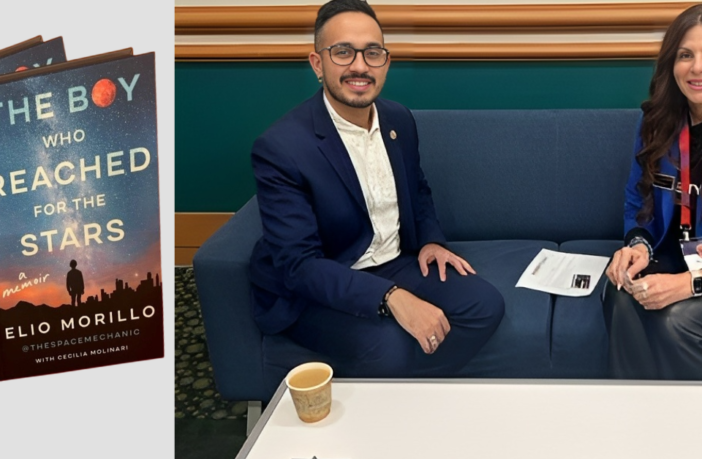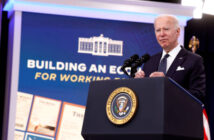At this year’s SHPE Conference (Society of Hispanic Professional Engineers), DiversityComm Magazine caught up with Elio Morillo, an engineer, writer and artist who strives each day to push the boundaries of inclusion and representation. Having just released his new memoir, The Boy Who Reached the Stars, Morillo took a moment to share his life experiences and journey with us below.
DiversityComm Magazine (DC): So, tell me, what made you ultimately decide to pursue a career in space exploration and how old were you when you first started?
Elio Morillo (EM): I think I’ve always thought of space as fascinating and incredibly cool. When I was young, I didn’t have any role models in my immediate vicinity by any means. But I grew up watching a lot of PBS and the History Channel, and it was always so clear that there were people behind these machines on TV; there were people designing, building and testing these incredible inventions. I learned that the folks building these machines were engineers. I never saw myself as different than those people. I was like, “Oh this is achievable.”
I also did a lot of drawing and painting growing up, and that’s what you essentially do as an engineer—you’re always creating new things, you’re solving complex problems. My mother was also a teacher who put an emphasis on getting good grades. That was a non-negotiable and it lined up with my passions for science and math. At home, I knew that I was going to go to college. My mom always told me that was going to be the case. We were going to figure it out in some way or form. So, it was always just a matter of I’m going to get there and I’ll figure out how.
DC: I couldn’t help but notice that you mentioned the arts, especially with the dilemma between whether STEM should be called STEAM, and you’re obviously a product of STEAM.
EM: Oh, 100%. I agree that you need the arts. I recently worked on the Mars mission and this is new stuff that no one’s working on. So, you literally have to come up with ways of solving problems that no one’s ever thought about. And truly, you do that with creativity.
I talk about them in my book, but I had two different art teachers growing up. One was named Artemio Rivera and he was a very eccentric, stereotypical artist, and then I had another teacher, Rosa Solivan, and she was very disciplined. So, learning the rigor and freedom from these two individuals; all of that absolutely has to do with the way I am as an engineer. I always tell people that if they love engineering to also practice their creativity.
DC: Tell me more about your work with the Perseverance and its significance. How did you feel watching it take off?
EM: Oh man, watching it take off in particular—it was one of the most special moments of my life and will forever be for a variety of reasons. I joined that team when we were in the middle of starting the testing program, so as you integrate the vehicle, you’re also building an Earth equivalent so that you can test everything that might go wrong in the real flight. I led a variety of testing campaigns and integrations of a lot of the different subsystems across the rover and also on the Ingenuity helicopter. I was also part of the operations team that eventually flew it for the first time and the engineering operation teams that focused on the mechanism’s daily behaviors. I was also the one who wrote the command that woke the rover up. It was the honor of a lifetime.
DC: What’s your background and where is your family from?
EM: I was born in Ecuador. My family’s Ecuadorian. I grew up between New York City and Puerto Rico. We left Ecuador because of the economic crisis that was there in the late nineties and to leave an abusive relationship my mother had with my father. Fortunately, we had some family to receive us in New York City.
My mom came here without knowing the English language and had to find odd jobs to make ends meet. She was a lifelong teacher, but was working jobs in cleaning, factories and food packaging. My brother then got married to a woman in Puerto Rico and moved out there. On a trip when we were visiting him, my mom ended up giving her resume to a few schools out there and got a job, so we decided to stay there. My Spanish is completely Puerto Rican so it throws people off when I tell them I’m from Ecuador.
DC: Where did you study and what is your experience in the industry?
EM: I ended up going to the University of Michigan for both my undergrad and graduate degrees while working at companies like SpaceX, GE Aviation and Boeing. I ultimately went to NASA JPL, where I worked on the Mars missions and now, I’m working at Blue Origin, working on the next lunar lander for the Artemis probe.
DC: What is the one message from your memoir that you’d like readers to take away and any advice you’d like to give for others walking in the same footsteps?
EM: Yes. I think the examples of community are what has driven me to where I am today, and I always tell people that it truly does matter who you surround yourself with. There, there’s a saying in Spanish, “quien andas, te diré quien eres,” which means, “tell me who you surround yourself with, and then I will tell you who you are.”
Although I did face a lot of adversity throughout my life, I always surrounded myself with love and support. The people I was with were these ambitious individuals who were always trying to push themselves to the best of their abilities in whatever their passions were. I think you feed off of that and it encourages you to do the same.
I would also say that you should never be afraid to ask for help. Continue learning and never stop!



